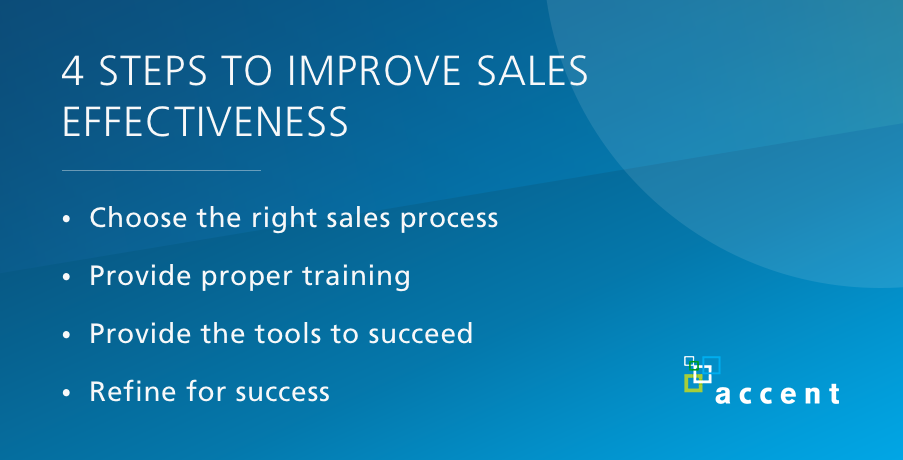uncategorised
How to Improve Sales Effectiveness
Is your sales team selling? Are they hitting their quotas and closing deals? If you answered yes to both of those questions, congratulations. Your work here is done, right?
Not so fast.
While it’s great your team is selling and hitting all their key performance indicators and quotas, could they be performing even better? Is your sales team being as effective and efficient as possible? If not, you could be missing out on even more success.
What is Sales Efficiency and Effectiveness?
At their core, sales efficiency and sales effectiveness are about one thing: driving sales.
When you really break them down, you’ll see that sales efficiency and effectiveness are two sides of the same coin. When they work in unison, good things happen.
Sales effectiveness is simply recognizing what methods your sales team is using to get clients to make purchases and determining how successful (or unsuccessful…) those tactics are.
Sales efficiency, meanwhile, is looking at all the things your sales department is doing to make sales and determining if there are ways they can be streamlined to achieve more with less effort.
Think of it this way – sales effectiveness is what you’re doing to make a sale, while sales efficiency is about how you’re doing the things that allow you to close deals.
When you combine these two things, the end result is often referred to as sales productivity. When you achieve more sales with less effort, overall sales productivity increases. This is a good thing.
Interested in learning how to increase sales effectiveness? Let’s dive in.
Why Improving Sales Effectiveness is Important
At this point, you may be thinking “my sales team is already hitting targets and closing deals – why would I be worried about sales effectiveness?”
You know, the old “if it ain’t broke, don’t fix it” philosophy.
But here’s the thing – while your team may be hitting quotas, if they’re not doing it in the most effective and efficient way possible, you could be leaving millions of dollars on the table.
As the old adage says, time is money – and too often salespeople waste valuable time looking for resources when they could be selling.
An Adobe survey noted that one of the most common bottleneck areas where sales effectiveness and efficiency falter in organizations is in accessing content.
In the study, they found that salespeople spent 18 minutes on average to find a piece of content. If they couldn’t find the content they needed, they then spent even more time creating it. This is incredibly inefficient, with mid-to-large size companies losing over $2.5 million annually because of this lost productivity.
How does sales ineffectiveness factor in here? Well, imagine that same salesperson then sending out whatever content he can find or cobble together without actually understanding if it fits the customer’s need. Sure, he did something – and may even luck into a sale, but how effective and efficient is that?
Wouldn’t it be better if he were actually sending out materials he didn’t have to spend 20 minutes locating and that were actually proven to be effective at converting?
This is why boosting sales effectiveness and efficiency is so important.

How Can I Improve Sales Effectiveness?
If your sales team is underperforming don’t panic – there are a lot of different ways to increase sales effectiveness.
Generally speaking, there are really two key components to increase sales effectiveness and efficiency: clearly define your sales process and analyze your sales team’s performance.
So, let’s break down some of the ways you can start working towards these two goals.
• Choose the right sales process
The first step is always about evaluating your current sales strategy, looking for weaknesses, and trying to find ways to improve it. Sounds simple enough, right?
A 2006 CSO Insights article basically breaks down the sales process into four different approaches. Each is relatively unique, and yet many companies will blend elements of more than one process into something that works for them. One of the first steps is understanding how each of these processes works.
First is the Random Process. Companies with this approach have no formalized document about how sales processes are handled. As the name implies, there’s not a lot of structure in this approach. Salespeople don’t work collaboratively, there’s little in the way of overall direction, and everyone basically does whatever they need to do to close a sale.
Next is the informal process. In this approach, there is a company-designed sales process, but there’s no real enforcement of it, so sales are still largely a free-for-all. This is a little more organized than the Random Process, but it’s still freewheeling and inefficient.
The third process is the Formal Process. Here the company has a well-defined approach to the sales process, they ensure everyone is following it, and it’s reviewed and revised regularly.
This method probably sounds like the ideal choice – and for some companies it is – but there’s a fourth option to consider as well.
The Dynamic Process is sort of the best of all worlds approach. Here your team has an overarching strategy, but it’s not quite as rigid as the Formal Process.
In the Dynamic Process, everything is fully integrated and shared. Data, techniques, KPIs – it’s all made available to the relevant parties so they can learn from it. In this plan, the team is completely aware of what’s happening, what works, what doesn’t, and what needs adjustment.
This is just a quick overview of the different processes – but knowing the basics, you can start to see where your sales department falls on the chart. Are you random with bits of informal? They you should probably start figuring out your roadmap to get to a more dynamic process level.
• Provide proper training
There’s a tendency in sales to believe that people on your team already know how to sell or will learn on their own. Many companies don’t have a training program at all, which is a huge oversight.
Regular training, playbooks, one-on-one coaching, and continuing education can help ensure your team is up to date not only the best techniques currently available, but they can also provide valuable feedback to you based on their experiences.
A career in sales may be a calling, but even the most gifted salesperson can benefit from extra training and attention. With a comprehensive sales enablement platform, you can even automate the training process. New AI technology makes it possible for the software to deliver sales tips, suggest next steps, and provide relevant content to the sales rep without requiring actual human involvement.
• Provide the Tools to Succeed
Training the team is great, but you can also take things a step further by ensuring you’re providing your team with the tools they need to be successful.
Providing access to Key Performance Indicators is just the beginning. If you’re not already using a sales enablement platform, it’s time to consider implementing one.
And while there is no shortage of sales enablement services on the market, it’s important to choose the right one for your team’s specific needs.
Advances in AI technology have led to more robust software that not only tracks your KPIs and provides real-time analytics, but also offer things like predictive and prescriptive analytics to help your team see opportunities they otherwise might have missed.
Sales enablement software is not a replacement for a great sales manager – but as AI and algorithms become more complex, it can certainly help a great manager make his team both more effective and efficient.
• Refine for Success
Once you’ve chosen your process and trained your team, it’s time to implement your plan and evaluate the results.
After the data’s been analyzed, this is the time to refine and adjust. What things are working? How can they be streamlined for even greater efficiency? What’s not working? Is it salvageable or is time to scrap it and go back to the drawing board?
This step is where the magic happens. At this stage of the process you’ve got data and can determine not only what’s effective, but also what can be made more efficient. Nailing it here can really take your sales program to a whole other level, so spend some time actually looking at your results. It will be worth it.
You might be wondering how you can best analyze this data – and the good news is that there’s a wide variety of sales enablement software on the market that can help you parse all this information.
Companies using sales enablement software generally see better sales numbers overall and have more salespeople hitting quotas (and remember – recent research shows that a full two-thirds of salespeople are not hitting their quotas. Anything that addresses this problem is a good thing).
Good sales enablement software helps salespeople close more deals by helping them work more effectively and efficiently. If you’re not using this technology, you should certainly consider exploring it in depth. It’s a game changer.
How to Measure Your Team’s Effectiveness
So, if you’re finding yourself thinking “maybe we should look into this sales enablement software”, but you don’t know where to start, we can help.
But before jumping into that, here are some key things to do to gauge how your team is doing right now.
1 Establish a Baseline
Before you can start making changes and seeing the big picture, you first have to know where your starting point is.
Sales enablement software can help with this by allowing you to monitor a wide range of sales activities. Track how many calls your reps are taking, how many emails they’re responding to, how many meetings they’re lining up, and so on.
If you don’t have a sales enablement software that’s tracking communications and activities, then it’s important to look for a comprehensive solution when you’re in the market. One that can help you backfill the historical data that you’re missing in CRM, so that you can create your baseline.
Once you know what the norm for your team is, you can start strategizing your next steps.
2 See Where Your Funnel is Clogged
Even the best sales funnels get clogged over time. It’s inevitable as products change.
But taking the time to figure out where your funnel is bottlenecking can yield huge dividends in your push to become more effective and efficient.
So, what should you be looking for in the funnel? Start with places where things bog down. Are there points along the customer’s journey where progress stalls and customers drop out? That’s a place that needs attention.
Don’t stop there, though – look at how long your customers are spending in each part of the funnel. How can you move them to the next stage more quickly? How can you streamline the journey? Solve these things and you’ll start to see both your efficiency and effectiveness increase.
3 Are you Acquiring New Customers?
Do you know how many new customers you’re getting per day/month/week on average? If not, you should find out.
Understanding new customer acquisition rates can be vitally important in increasing efficiency and effectiveness.
For example, if you’re getting the bulk of your new customers from one region or platform, it makes sense to ensure you have enough of your sales team working in that particular area to meet the needs of your clients. Having too few reps slows down everything – decreasing both efficiency and effectiveness.
By the same token, knowing new customer acquisition rates for each individual salesperson can help you learn who’s performing well, who’s struggling, and devise ways to help everyone achieve their goals with greater efficiency.
It’s equally important to know your customer attrition rates as well. Measuring both of these metrics can help you strategically prioritize your manpower, and make sure individual team members are putting forth their best effort.
4 Revenue
And we’ve saved the most obvious for last.
At the end of the day, everyone is graded by the amount of money they generate – that’s just life in the business world.
And yet, while revenue is obviously very important, don’t base everything on it. It’s important to have some level of perspective when looking at the numbers. There are countless variables that can affect them both positively and negatively, but over time examining revenue can provide a pretty reliable snapshot of how effective and efficient your sales efforts are.
Just don’t forget to use the other metrics out there too…
SEE ALSO: Buyer Energy – The Real Measure of Sales Effectiveness
Next Steps
As you can no doubt see, increasing sales effectiveness (and efficiency) is one of the best ways to increase revenue and grow the bottom line. And the best part? It’s not hard to do.
Whether you opt for traditional solutions or adopt sales enablement software, there are a lot of different options to help your team become a lean, mean selling machine right at your fingertips.
Accent Technologies is the first and only SaaS company to bring together Sales AI and Content Management in a true REVENUE ENABLEMENT PLATFORM. We provide both sales and marketing with better visibility into the performance of their teams, as well as their effectiveness with their customers. Through rich data analysis and intelligent recommendations for complex sales scenarios, the Accent platform empowers sales organizations to provide better coaching, forecasting, a more personalized buying experience, and stronger long-term customer support. Learn more about our solutions or request a LIVE DEMO to see it in action.











